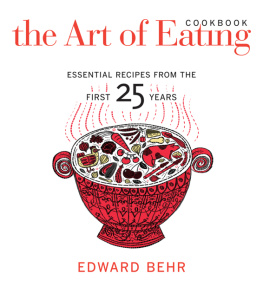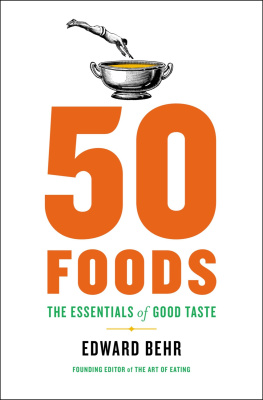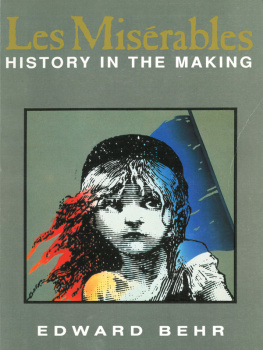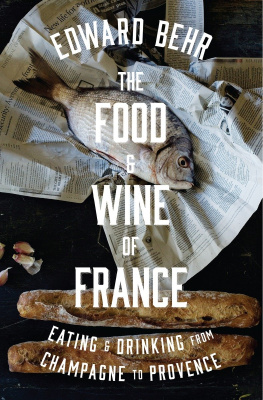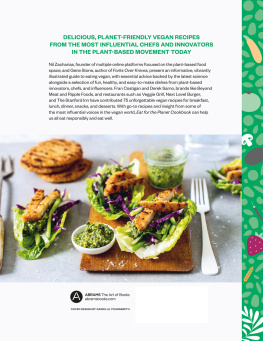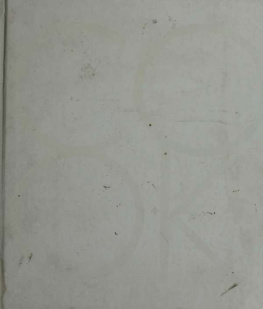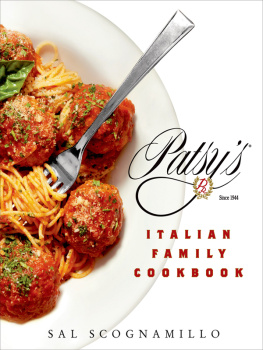SCHIACCIATA
Flat Hearth Bread
BREAD MAKES OTHER FOOD TASTE BETTER. Potatoes, rice, and other starches do the same, but not with the same flavors of fermentation or textural contrasts as bread. It enhances a salad, fresh cheese, or grilled meat as much as it does sauces, strong cheeses, or cured meats. You can eat a lot of very fresh bread, but older bread is good, too, as in the age-old use of a slice in a bowl of soup. A baguette, a grainy country loaf, sour ryeall have their place, according to what else is on the table. A meal can be anything you want; it can start and end where you like. It can be a single item, such as a big bowl of soupa beginning and an ending in oneor it can run on in multiple courses. But, at least in the context of Western cooking, nothing is more important than bread. That so many restaurants in English-speaking countries treat bread as an appetizer is an utter misunderstanding or maybe a giving up in the face of customers who dont get bread. This and the two recipes that follow are for unfermented or mildly fermented breadsmore ambitious bread baking, with all its complications of flour, leavenings, and ovens, fits better in its own book. But each of the breads here has its attractions of texture and flavor. The four other recipes are for items that especially require bread.
Schiacciata, which literally means flattened or squashed, is a kind of focaccia. Even in places where the dominant bread was big and round, flatbreads were once almost universal too. Forming some of the bread dough into flat rounds was a way to test the ovens heatin the oldest type of wood-fired oven, schiacciate go in first, when the temperature is highest. The interior of this Tuscan-style schiacciata makes a sweet contrast with the salty crust, because the dough itself contains no salt. But dough without salt ferments more quicklyoften too quickly to gain real flavor. The best solution is probably a sourdough leavening, traditional for Tuscan bread (though rare today), but that requires special knowledge, not to say practice and devotion. And the simple commercial-yeast sponge below provides good flavor.
For easier stretching, water in a proportion of 75 percent of the flour by weight (the bakers way of measuring), as below, works well with American unbleached all-purpose white flour at about II percent protein; softer flour, like that used in Italy, requires less water. The salt sprinkled on top should be fine, not coarse. You need at least a couple of schiacciate to feed six or eight hungry people, but a home oven will bake just one at a time, so inevitably the second ferments more than the first. Fortunately, the fast cooking in a hot oven overrides much of the difference, and in this bread a lot of flavor comes from the broad expanse of brown crust.
teaspoon (2 gr) instant yeast
3 cups (500 gr) unbleached all-purpose flour
1 cups (375 ml) water at about 80 F (27 C)
excellent, fresh-tasting olive oil or melted lard
fine salt
coarse semolina
Mix the yeast with 1 cup (130 gr) of the flour and 1 cup (240 ml) of the water. Cover and leave overnight in a cool spot, cooler than 70 F (21 C). Then combine this sponge with the rest of the flour and water to make a soft dough, mixing it only enough to incorporate the flour fully. Put the dough in a bowl, cover it, and place it in a warm spot, 75 to 80 F (24 to 27 C), to rise for 2 hours. Then lift up one side of the dough and fold it onto the other, pressing lightly so the two adhere, cover again, and leave to rise for another hour.
Half an hour into the second rise, set an oven rack in the top half of the oven and line it with a baking stone or quarry tiles. Heat the oven to 500 F (260 C). When the rising time is up, turn the dough out of its bowl and cut it in half with a dull edge. Flatten each half with an open handrolling would press out too many bubblesand then stretch each half to an even round about 12 inches (30 cm) wide. Onto each pour a spiraling thread of oil or melted lard or brush the top minimally with oil or lard. More generously, sprinkle each with salt. Let the rounds rise for 10 minutes. Sprinkle a peel or open-sided baking sheet lightly with semolina and place one round on it. With your fingers, press a dozen or more dimples into the top of the dough, and slip the loaf quickly and confidently off the peel onto the stone or tiles. Remove when well browned, after about 15 minutes, then promptly bake the other round. Serve warm. Makes 2 loaves.
CORN BREAD
MARY RANDOLPH PUBLISHED THIS RECIPE in her fine cookbook The Virginia Housewife, in 1824, before chemical baking powders transformed American baking. She counted on eggs for loft, or, as here, yeast. Industrial cornmeal has very little flavor, and most of the interest in corn bread comes from using the best cornmeal you can find. The more freshly ground, the better the flavor; the highest quality tends to come from old milling varieties of corn that are stone-ground. In the South, the color of cornmeal is usually white and, as a rule, white and yellow cornmeals have distinct flavors, the first often being earthier and the second richer. Finely ground meal rises higher. Mary Randolph made muffins with her batter; I bake it in a skillet.
2 cups (300 gr) cornmeal
cup (50 gr) unsalted butter plus more for the pan
scant teaspoon salt
teaspoon (2 gr) instant yeast
2 large eggs
1 cup (240 ml) warm milk
Place the cornmeal in a large bowl and rub the butter into it using your fingers, until the combination loses and then regains the consistency of meal. Add the salt, yeast, and eggs. Stir in enough of the warm milk to make a medium-thick batter (finer meal will absorb more liquid). Cover the bowl and set it in a warm spot, at least 80 (27 C), for about 2 hours, during which time, lacking the gluten of wheat, the batter will rise only slightly, increasing by perhaps one-eighth.
Heat the oven to 450 F (230 C). Butter a black castiron frying pan about 10 inches (25 cm) wide and set it, empty, in the oven to heat to almost smoking hot. Remove it, immediately fill it with the batter, and return it to the oven to bake until the corn bread is set, 12 to 15 minutes. Serve promptly. Serves 4.
FARINATA
Chickpea Pancake
ONCE A COMMON STREET FOOD, FARINATA IS A VAST chickpea pancake, soft and floppy, baked in special heavy copper pans about a yard wide; you eat pieces with your fingers. Farinata is mainly Ligurian, but its made on a long stretch of the Mediterranean coast from Nice, where the name is socca, through Liguria, where in dialect its called fain, into neighboring Tuscany, where its cecina. You can bake a very good farinata in a home oven using a smaller pan, although the transformation of batter to bread is less remarkable than it is in the traditional wood-fired oven, whose physics produce powerful heat. Its important that the chickpea flour taste nutty, and strongly of chickpeas. At some natural food stores, it tastes like green peas; better-quality chickpea flour is sold at some Italian and Indian food shops. Different farinata recipes call for different proportions of chickpea flour to waterfor different tastes, thicknesses, or ovens. A very hot masonry oven requires a thin batter; thicker batters are for home ovens. Before cooking, you can add some chopped fresh rosemary or thyme, or green onions chopped at the last minute (if they wait half an hour, youll taste the difference).

